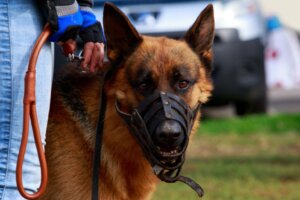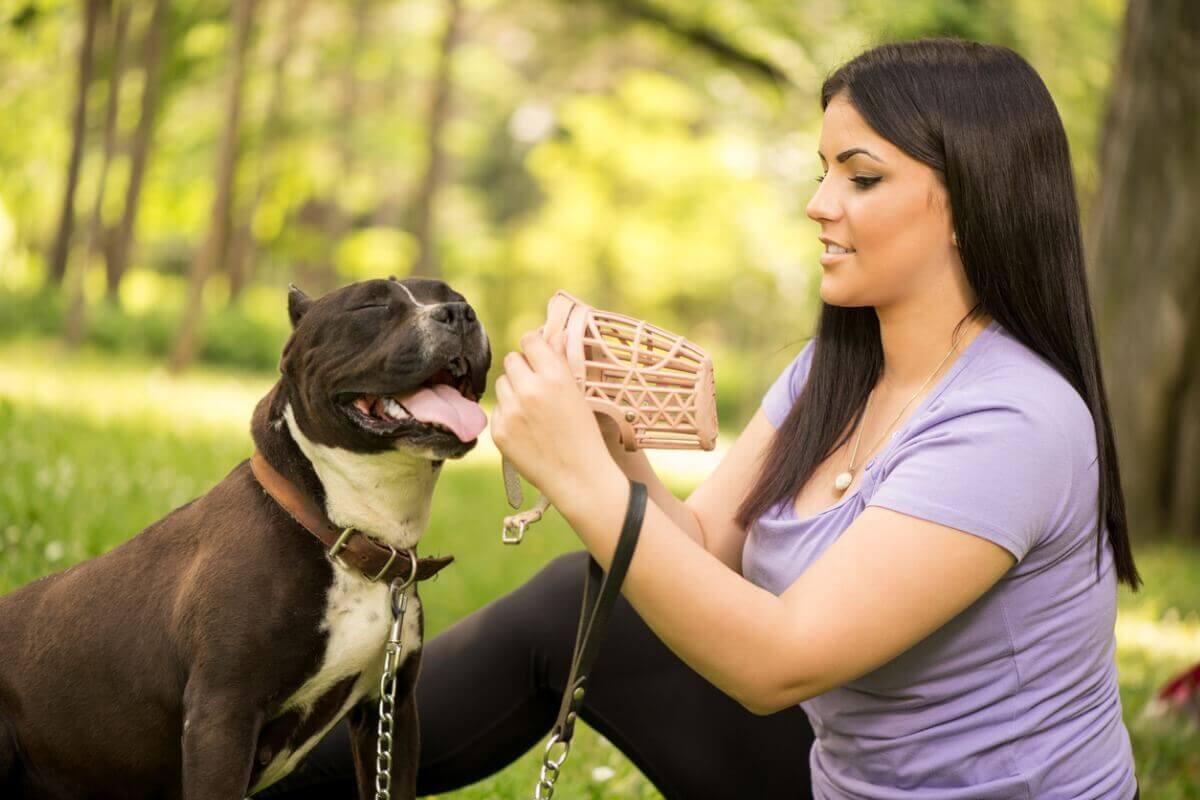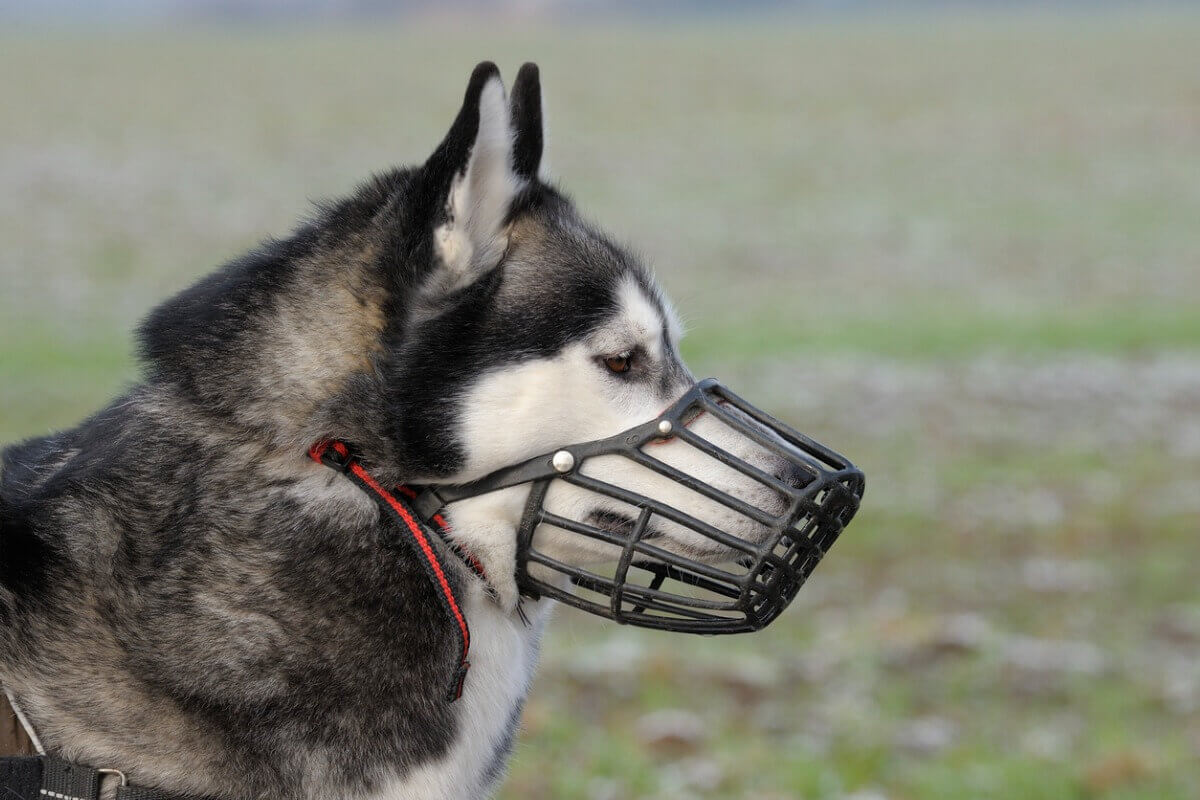How to Get a Dog Used to a Muzzle?

Getting a dog used to a muzzle isn’t as simple as you may think if you’ve never had to do it. First of all, there must be a proper process of introduction between the object and the dog so that its use isn’t associated with stress or discomfort in the long term.
You need to remember that breeds classified as “potentially dangerous” should always use muzzles in public places. Although the rule is limited to specific dogs, it’s the duty of any owner to place this device on their furry friend if it’s shown aggressive behavior. Not only can this act prevent accidents, but it also serves to correct the negative behavior in question.
Keep reading, as we’ll explain how the introduction process should take place so you can successfully get your dog used to a muzzle without any problems. Patience is always the key.
Muzzles for dogs
The use of a muzzle for dogs is mandatory in the case you own a dog of any of the potentially dangerous breeds. However, this device can also be used to correct and control aggressive behaviors in any dog. For example, it’s useful when you must take the pet to the vet and it shows resistance, or if you have to protect your dog from a potential physical injury.
The market offers different types of muzzles, but which is the most suitable? The basket-shaped variant is one of the most recommended because it allows canines to breathe without difficulty, something that does not happen with cloth muzzles. In addition, this model offers space for animals to drink water and receive their treats without having to remove the protective object.
At the same time, you should check that the muzzle you choose has good straps so that it doesn’t fall off, and be sure to adjust it according to the anatomy of each pet. Don’t get carried away only by the color or design: The most important thing is to think about the health, safety, and comfort of pets.
It’s important that you learn how to handle the muzzle on your own before introducing your dog to the device. Try fastening and adjusting the straps beforehand so that you don’t transfer your own insecurity to the dog.

How to introduce a muzzle to a dog?
Although it’s best to introduce a muzzle to a dog when it’s a puppy, it’s okay if this happens in adulthood. Studies have shown that the best age for training dogs is 6 years old. Don’t be afraid of how your furry friend will act if it’s older, even more so if it’s just going to interact with this protective implement in the time it has left.
Once you’ve learned to handle the muzzle, it’s time to introduce it to your 4-legged friend. Remember that you’ll need time, patience, and willingness to do it because the idea is for the dog not to associate the object with negative things. A bad experience will increase reluctance.
Let the pet smell the muzzle, but keep them from biting it, as it’s not a toy. Let the dog get to know it, touch it, and encourage your pet gently if it lets you put the muzzle on. This will be a time-consuming task, as it involves several concrete steps.
What to do to get a dog used to a muzzle
Presenting the muzzle to a dog and letting it sniff it isn’t enough to get your pet used to wearing one. There are a series of steps you can follow in order to successfully get your dog to use it with total appropriation. Keep reading!
Associate the muzzle with positive education
Associating the muzzle with something positive will make it easier for your dog to use it. Every time you take the accessory out, let it sniff it and create a fun environment where you can put on the muzzle without forcing your dog or fastening it. If the animal allows it, offer a treat.
Choose your dog’s favorite snacks and make a path with them. At the end of it all, place a biscuit inside the muzzle so the dog can put it on by himself while it enjoys the reward. You should also provide positive reinforcement: A snuggle, a hug, or a larger treat, for example.
Another option is to take the muzzle in one hand and show it to the dog, but don’t put it on. Just encourage your pet to come to your hand to sniff it and, when it does, offer a treat. Hide the object for a moment and bring it out again to repeat the process.
Choosing the right muzzle
Not all muzzles work equally well for dogs, as they come in different sizes depending on the breed for which they’re intended. You must find the right size for your pet, as using an inadequate one can hurt their snout and increase the perceived bad experience.
Basket type muzzles are the most recommended, as they allow the dog to breathe without difficulty, pant, and drink water when needed, all without having to remove the protective device. Another important aspect is the material it’s made of, as it must be resistant so that it’s not easily damaged (not even if the dog tries to bite it).
Get your dog used to a muzzle little by little
Another important step to getting a dog used to the muzzle is to introduce it little by little. You should never force your pet to use this element from one day to the next, as this will only cause stress and aversion. Also, keep in mind that the recommendations we gave you before should be done at least 3 times a week. Otherwise, the dog won’t take the process seriously.
When you notice that the canine uses the muzzle in the middle of a game or allows you to put it on without much trouble, try to fasten it calmly and be very sure of what you’re doing. Then you can move on to the next step.
Practice and generalization of the muzzle
When your dog agrees to wear the muzzle without resistance, it’s time to get it used to the act for short periods of time. Start the practice with 1 minute of use, and then remove the device and provide a treat at the end. Because the sessions are so short, you can repeat them 2 or 3 more times a day.
The following week, increase the time to 2 or 3 minutes of practice. After this stage, it’s time to generalize the use of the device. This consists of putting the muzzle on for a couple of hours in the house, then in the yard, and finally trying it out in the park.
When you’re out of the house, the adaptation stage is divided into two parts: Using the muzzle with and without a leash. Until your dog is completely used to the muzzle, supplement the practice with treats and positive reinforcement.
How to properly muzzle a dog
Properly muzzling a dog is easy. Follow the steps listed below:
- Introducing the muzzle: Never force your dog. Place the muzzle on the floor and put a treat inside, so your pet will come to put it on by itself.
- Fasten the muzzle: While your dog enjoys a tasty treat, fasten the muzzle quickly and securely over its snout.
- Wearing the muzzle: Now all that’s left to do is to put the leash on your dog and set off for your destination.

Getting a dog used to a muzzle isn’t an easy task, as it requires patience and a lot of commitment on the part of the owner. However, at the end of the educational process, it will all be worth it. You won’t have to force your furry friend to go out with its protection because, if you do it right, your dog will learn to put the device on almost by itself.
Getting a dog used to a muzzle isn’t as simple as you may think if you’ve never had to do it. First of all, there must be a proper process of introduction between the object and the dog so that its use isn’t associated with stress or discomfort in the long term.
You need to remember that breeds classified as “potentially dangerous” should always use muzzles in public places. Although the rule is limited to specific dogs, it’s the duty of any owner to place this device on their furry friend if it’s shown aggressive behavior. Not only can this act prevent accidents, but it also serves to correct the negative behavior in question.
Keep reading, as we’ll explain how the introduction process should take place so you can successfully get your dog used to a muzzle without any problems. Patience is always the key.
Muzzles for dogs
The use of a muzzle for dogs is mandatory in the case you own a dog of any of the potentially dangerous breeds. However, this device can also be used to correct and control aggressive behaviors in any dog. For example, it’s useful when you must take the pet to the vet and it shows resistance, or if you have to protect your dog from a potential physical injury.
The market offers different types of muzzles, but which is the most suitable? The basket-shaped variant is one of the most recommended because it allows canines to breathe without difficulty, something that does not happen with cloth muzzles. In addition, this model offers space for animals to drink water and receive their treats without having to remove the protective object.
At the same time, you should check that the muzzle you choose has good straps so that it doesn’t fall off, and be sure to adjust it according to the anatomy of each pet. Don’t get carried away only by the color or design: The most important thing is to think about the health, safety, and comfort of pets.
It’s important that you learn how to handle the muzzle on your own before introducing your dog to the device. Try fastening and adjusting the straps beforehand so that you don’t transfer your own insecurity to the dog.

How to introduce a muzzle to a dog?
Although it’s best to introduce a muzzle to a dog when it’s a puppy, it’s okay if this happens in adulthood. Studies have shown that the best age for training dogs is 6 years old. Don’t be afraid of how your furry friend will act if it’s older, even more so if it’s just going to interact with this protective implement in the time it has left.
Once you’ve learned to handle the muzzle, it’s time to introduce it to your 4-legged friend. Remember that you’ll need time, patience, and willingness to do it because the idea is for the dog not to associate the object with negative things. A bad experience will increase reluctance.
Let the pet smell the muzzle, but keep them from biting it, as it’s not a toy. Let the dog get to know it, touch it, and encourage your pet gently if it lets you put the muzzle on. This will be a time-consuming task, as it involves several concrete steps.
What to do to get a dog used to a muzzle
Presenting the muzzle to a dog and letting it sniff it isn’t enough to get your pet used to wearing one. There are a series of steps you can follow in order to successfully get your dog to use it with total appropriation. Keep reading!
Associate the muzzle with positive education
Associating the muzzle with something positive will make it easier for your dog to use it. Every time you take the accessory out, let it sniff it and create a fun environment where you can put on the muzzle without forcing your dog or fastening it. If the animal allows it, offer a treat.
Choose your dog’s favorite snacks and make a path with them. At the end of it all, place a biscuit inside the muzzle so the dog can put it on by himself while it enjoys the reward. You should also provide positive reinforcement: A snuggle, a hug, or a larger treat, for example.
Another option is to take the muzzle in one hand and show it to the dog, but don’t put it on. Just encourage your pet to come to your hand to sniff it and, when it does, offer a treat. Hide the object for a moment and bring it out again to repeat the process.
Choosing the right muzzle
Not all muzzles work equally well for dogs, as they come in different sizes depending on the breed for which they’re intended. You must find the right size for your pet, as using an inadequate one can hurt their snout and increase the perceived bad experience.
Basket type muzzles are the most recommended, as they allow the dog to breathe without difficulty, pant, and drink water when needed, all without having to remove the protective device. Another important aspect is the material it’s made of, as it must be resistant so that it’s not easily damaged (not even if the dog tries to bite it).
Get your dog used to a muzzle little by little
Another important step to getting a dog used to the muzzle is to introduce it little by little. You should never force your pet to use this element from one day to the next, as this will only cause stress and aversion. Also, keep in mind that the recommendations we gave you before should be done at least 3 times a week. Otherwise, the dog won’t take the process seriously.
When you notice that the canine uses the muzzle in the middle of a game or allows you to put it on without much trouble, try to fasten it calmly and be very sure of what you’re doing. Then you can move on to the next step.
Practice and generalization of the muzzle
When your dog agrees to wear the muzzle without resistance, it’s time to get it used to the act for short periods of time. Start the practice with 1 minute of use, and then remove the device and provide a treat at the end. Because the sessions are so short, you can repeat them 2 or 3 more times a day.
The following week, increase the time to 2 or 3 minutes of practice. After this stage, it’s time to generalize the use of the device. This consists of putting the muzzle on for a couple of hours in the house, then in the yard, and finally trying it out in the park.
When you’re out of the house, the adaptation stage is divided into two parts: Using the muzzle with and without a leash. Until your dog is completely used to the muzzle, supplement the practice with treats and positive reinforcement.
How to properly muzzle a dog
Properly muzzling a dog is easy. Follow the steps listed below:
- Introducing the muzzle: Never force your dog. Place the muzzle on the floor and put a treat inside, so your pet will come to put it on by itself.
- Fasten the muzzle: While your dog enjoys a tasty treat, fasten the muzzle quickly and securely over its snout.
- Wearing the muzzle: Now all that’s left to do is to put the leash on your dog and set off for your destination.

Getting a dog used to a muzzle isn’t an easy task, as it requires patience and a lot of commitment on the part of the owner. However, at the end of the educational process, it will all be worth it. You won’t have to force your furry friend to go out with its protection because, if you do it right, your dog will learn to put the device on almost by itself.
All cited sources were thoroughly reviewed by our team to ensure their quality, reliability, currency, and validity. The bibliography of this article was considered reliable and of academic or scientific accuracy.
- Chopik, William J., Weaver, Jonathan R. Old dog, new tricks: Age differences in dog personality traits, associations with human personality traits, and links to important outcomes. Journal of Research in Personality. 2019. Doi: https://doi.org/10.1016/j.jrp.2019.01.005
- Muzzles: a tool to keep everyone safe, Save them all. Recogido a 25 de octubre en https://resources.bestfriends.org/article/muzzles-tool-keep-everyone-safe
This text is provided for informational purposes only and does not replace consultation with a professional. If in doubt, consult your specialist.








